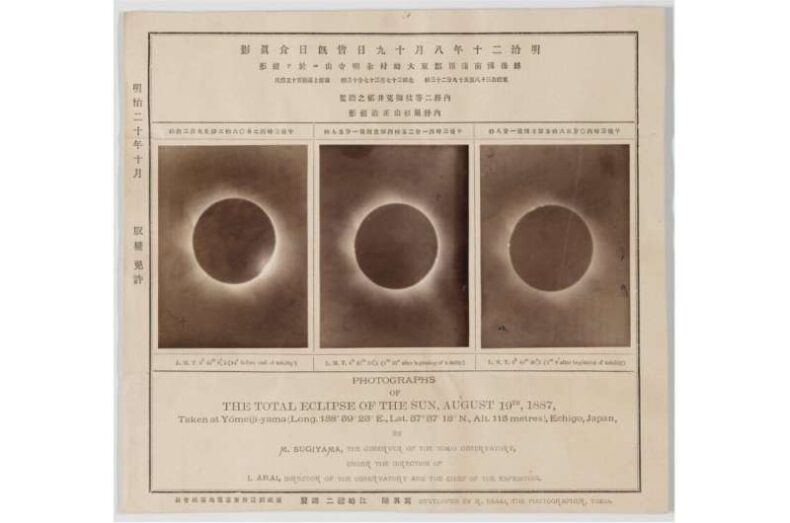These records, though expressed in the artistic and imaginative descriptions of the time due to limited scientific evolution, correlate with real-life solar elliptical events.
Researchers from Nagoya University, the National Astronomical Observatory of Japan, and the Otaru University of Commerce discovered and studied specific data for three ancient eclipses using a combination of written materials, folklore, and astronomical calculations. One of the most well-known Shogunate explorers for Hokkaido, Sakhalin, and the Kuril Islands, the islands situated between Japan and Russia, Tokunai Mogami (1755–1836), is mentioned in the scriptures.
Folklore and historical literature are neglected sources of information for studying past astronomical events. Oral and written records can be used as starting points for astronomical research of occurrences like solar eclipses, even though they are frequently distorted by imaginative descriptions or the primitive knowledge of the time.
Such historical documents are uncommon yet significant on Hokkaido, the largest island in northern Japan. Hokkaido has fewer historical sources than Japan’s main island of Honshu since there are fewer Japanese residents there and the indigenous Ainu were less likely to record the dates of certain occurrences before the Meiji Period. However, the scant literature on astronomical events offers a great starting point for scientific investigation. There is a chance for exciting new findings when local historical and cultural knowledge is combined with cutting-edge scientific methodologies.
Along with Mitsuru Sôma of the National Astronomical Observatory of Japan and Ryuma Daigo of the Otaru University of Commerce, Hisashi Hayakawa of the Institute for Space-Earth Environmental Research (ISEE) and the Institute for Advanced Research (IAR) at Nagoya University examined three historical writings and sketches to see if they could use contemporary research techniques to identify the actual astronomical events described.
They studied the written materials for their study in the Publications of the Astronomical Society of Japan before computing the spatial correlation of the sun and moon as people would have viewed them from various locations in Hokkaido.
The earliest of these stories came from a letter written by John Batchelor (1855–1944), an Anglican missionary to the Ainu who also wrote extensively on their way of life. Some of these writings described a total solar eclipse as having “tongues of fire and lightning from its sides” and emanating from a “dead black sun,” according to ancestors’ Ainu legend.
The research team discovered that the eclipse report exactly matched a total solar eclipse by comparing these historical descriptions with computer simulations of the sun and moon’s locations. It’s possible that the vivid description of a “black dead sun” applied to the eclipsed sun. Similarly, solar coronal streamers, which are brief flashes of light from the sun, appeared to be described as “tongues of fire and lightning.”
The scholars also looked over Tokunai Mogami’s journals as an explorer and geographer. The earliest datable testimony of a solar eclipse seen in Hokkaido dates back to 1786, when Mogami recounted the account of a local trader named Denkichi Abeya. This journey had been connected to an annular eclipse, in which the moon blocks the sun’s centre and creates a halo of light around it. Hayakawa and his crew discovered that this marginally deviated from reality. Mogami really appeared to be describing a deep partial solar eclipse that was outside the path of a hybrid eclipse, a rare occurrence that combines both an annular and total eclipse.
Finally, the researchers also made use of sketches from 1872 that was published in Kan’ichiro Mozume’s (1840–1877) diary. Mozume was a teacher and thinker from the area. The solar eclipse is depicted in four phases in his sketches. The researchers connected Mozume’s drawings to an annular eclipse that occurred in June 1872 but for which no documented eclipse records exist. Astronomical calculations indicate that it would have been seen in the western Hokkaido town of Otaru.
The intersection of astronomy and historical research may be seen clearly in this study.
“Astronomical calculations with the latest parameters have independently confirmed historical documents and folklore from the 18th and 19th centuries,” says, Hayakawa. “Our research has also filled the geographical gaps in eclipse observations in Japan. “Further research on the folklore eclipse accounts could be of future scientific interest, too.”


read more : The Lunar Eclipse of 2022: The total lunar eclipse will be visible in which cities in India, Let’s find out.












